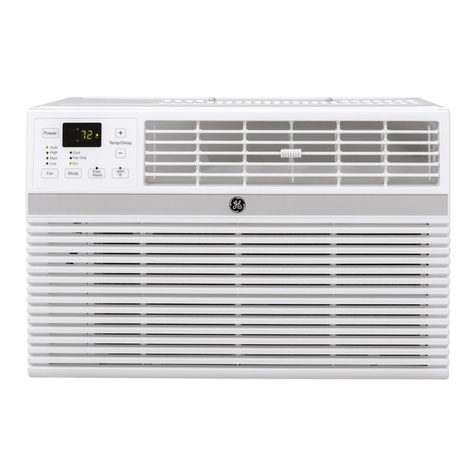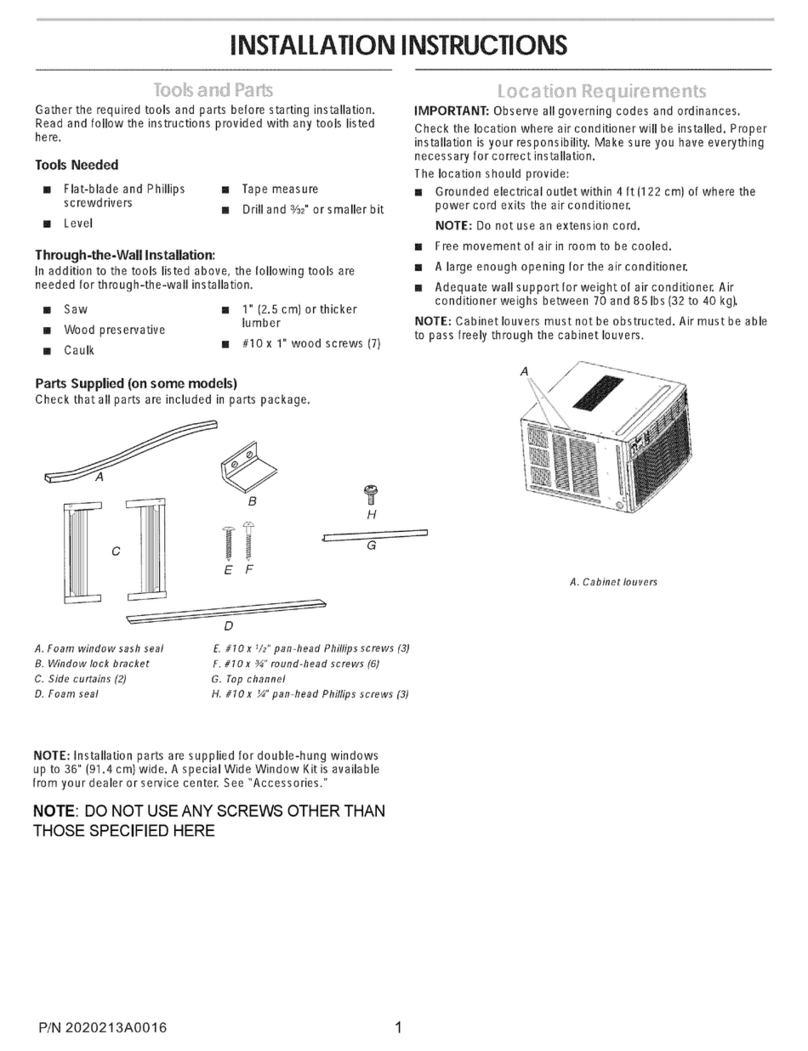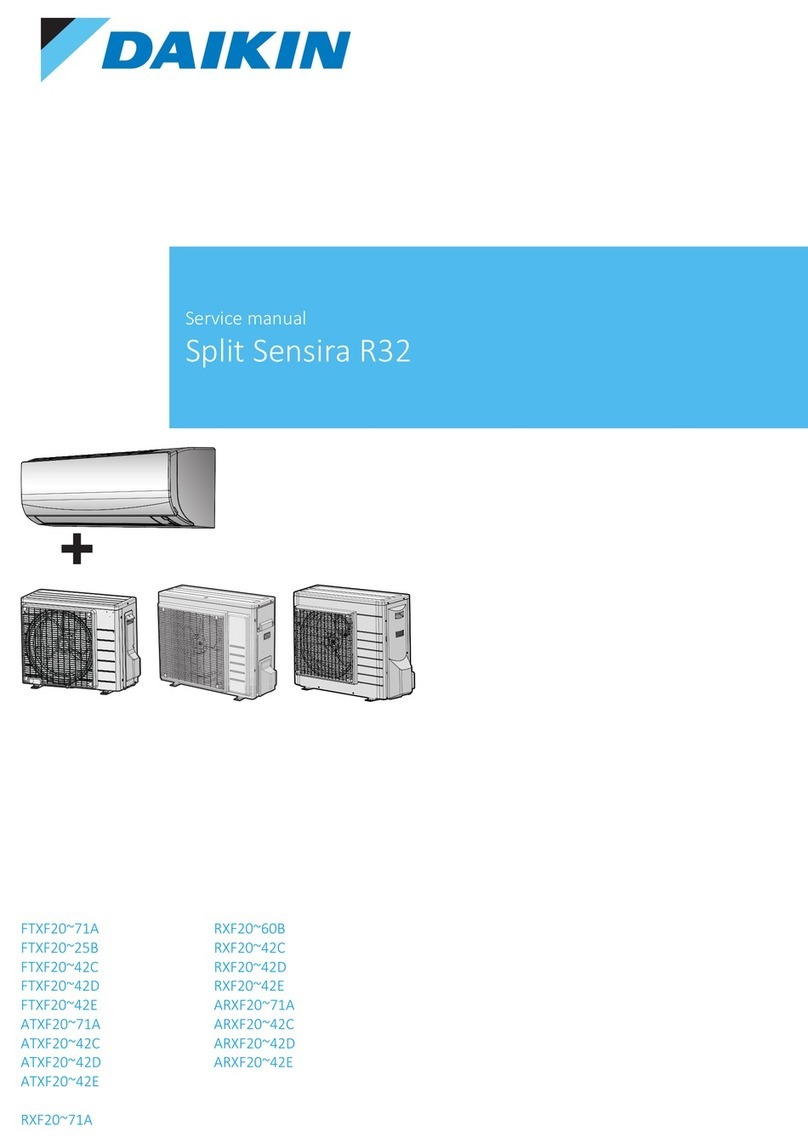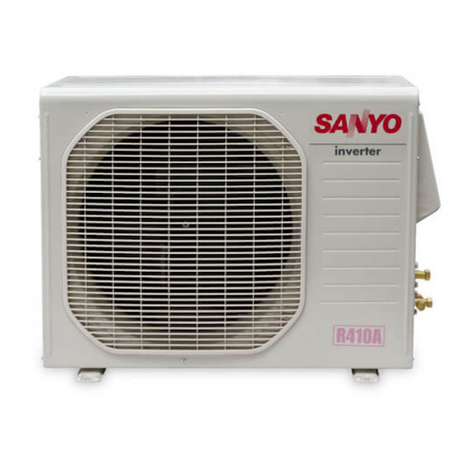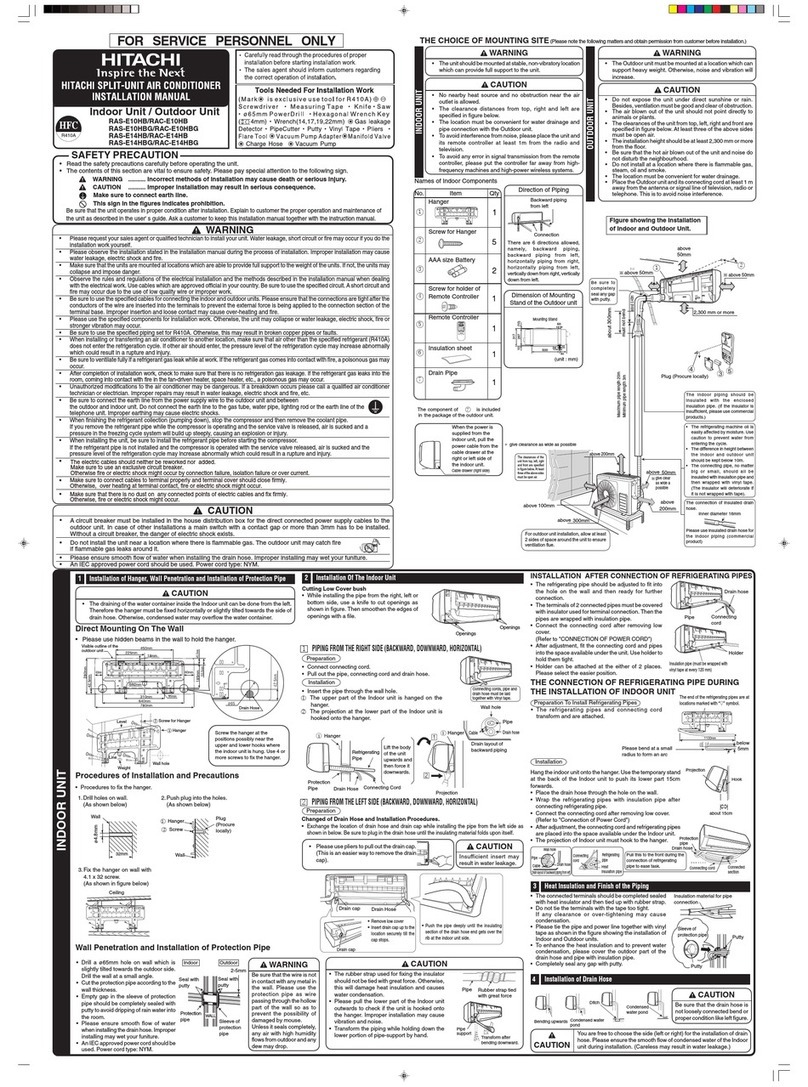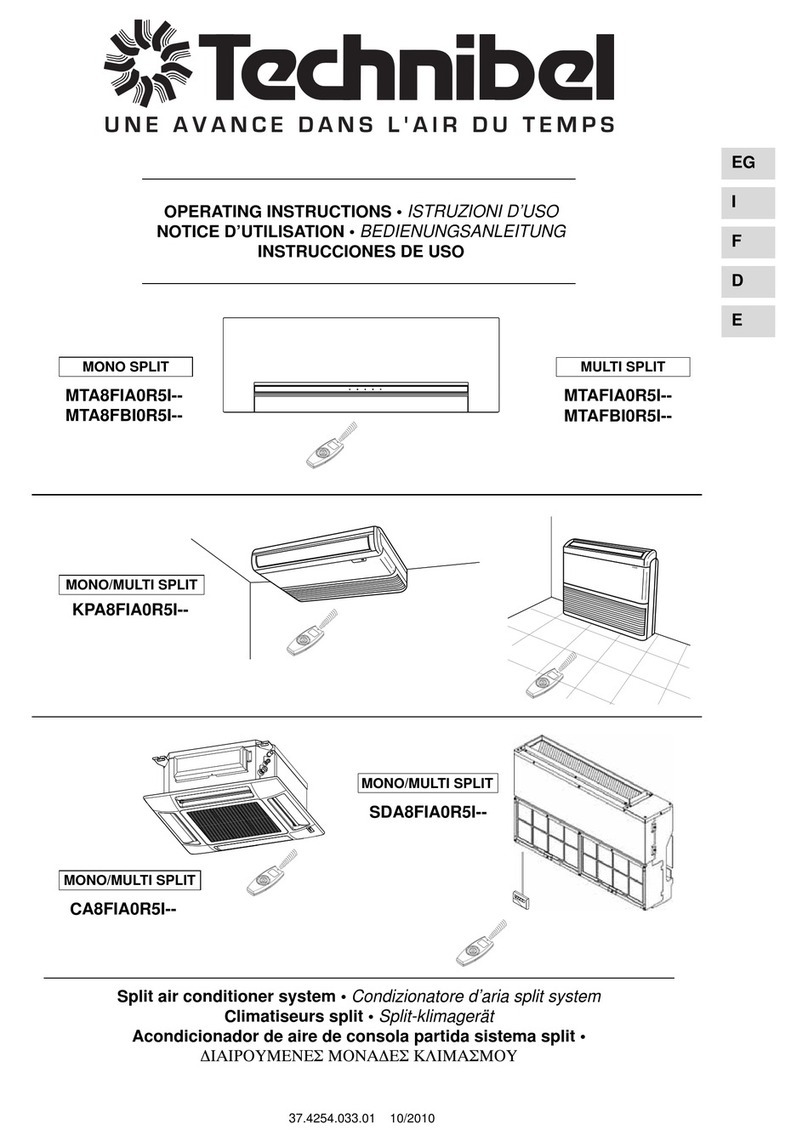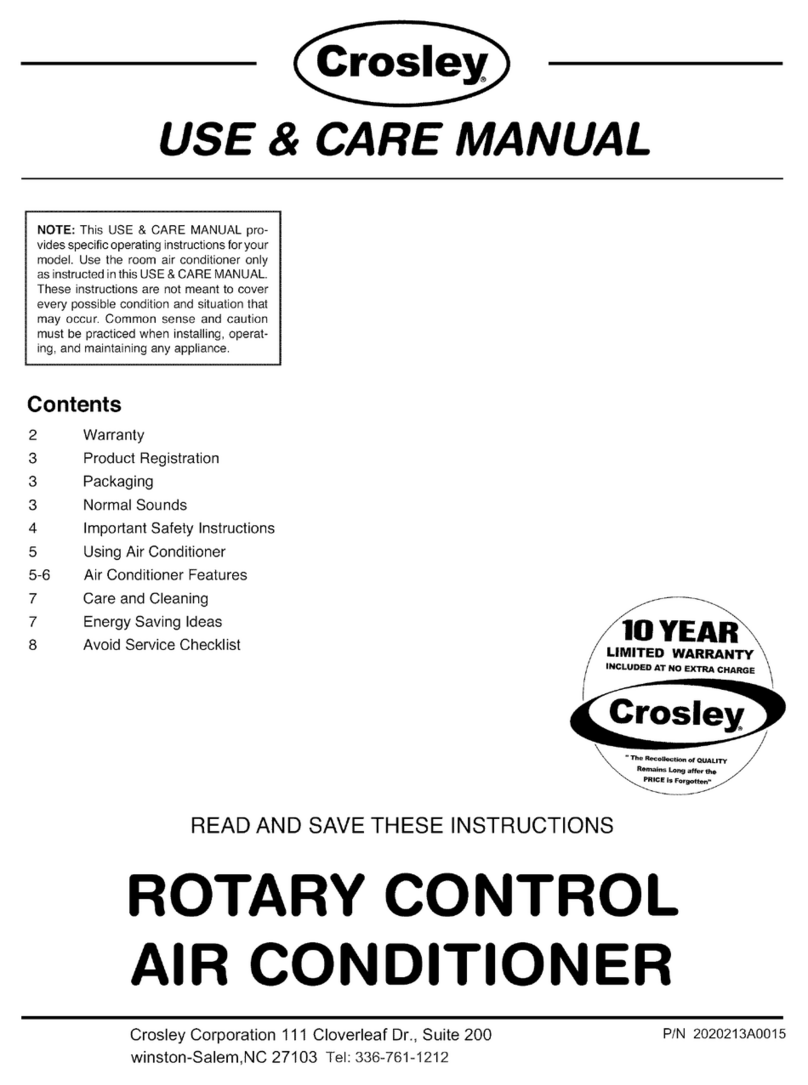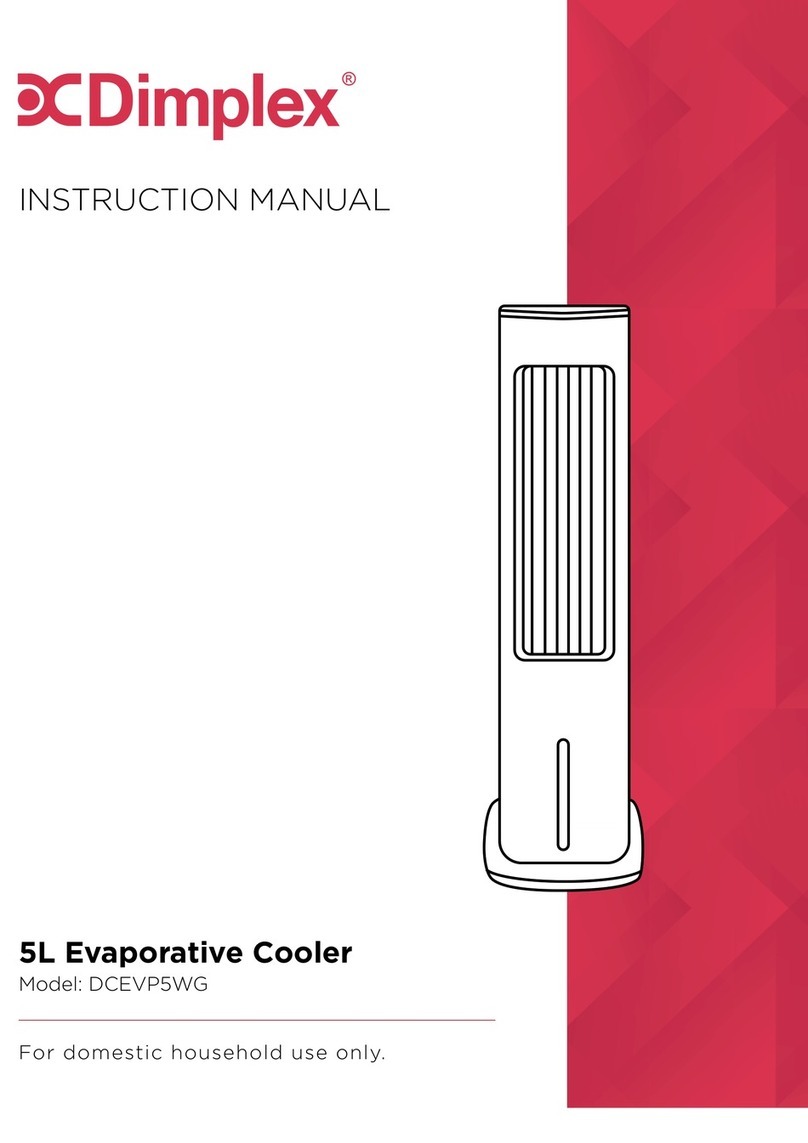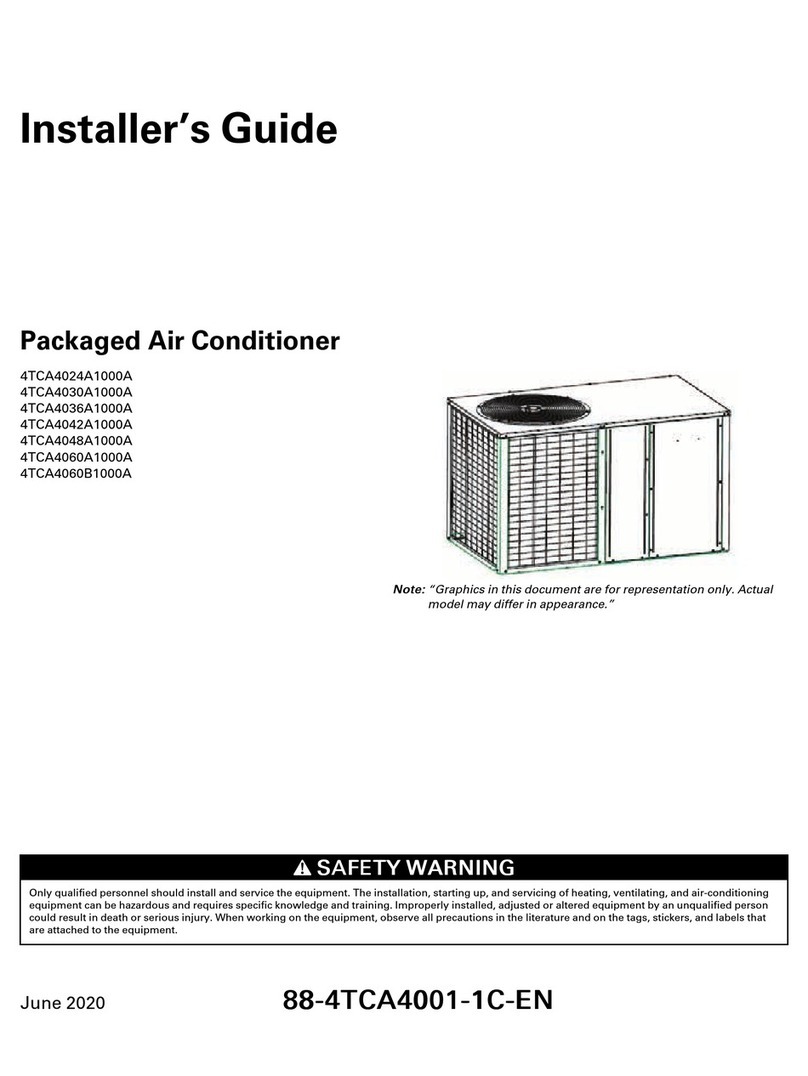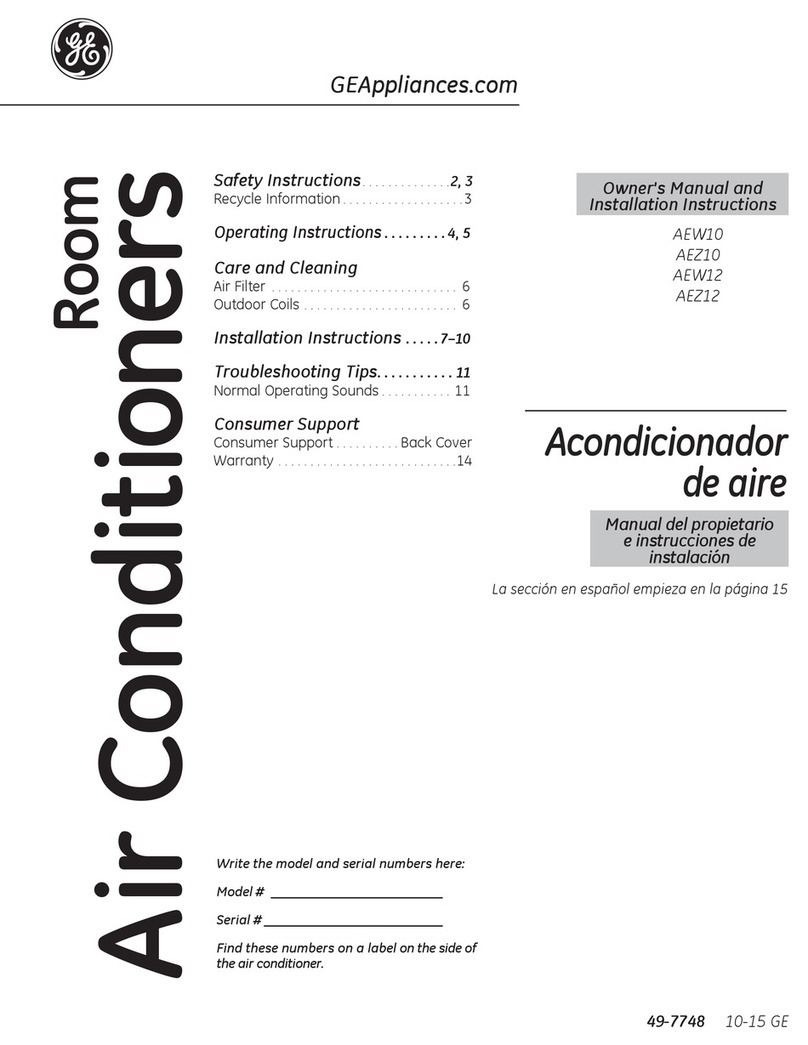NORPOLE NPRAC6KEWMZ1 User manual

1
READ THIS MANUAL CAREFULLY BEFORE USING YOUR WINDOW AIR
CONDITIONER AND KEEP IT FOR FUTURE REFERENCE.
Model NPRAC6KEWMZ1 / NPRAC8KEWMZ1 / NPRAC10KEWMZ1 / NPRAC12KEWMZ1
Window Air Conditioner
6000 / 8000 / 10000 / 12000 BTU
User’s Manual

2
PRODUCT REGISTRATION
Thank you for purchasing a Norpole® product. The rst step to protect your new product is to complete the product
registration on our website: www.mcappliance.com/register. The benets of registering your product include the following:
1. Registering your product will allow us to contact you regarding a safety notication or product update.
2. Registering your product will allow for more efcient warranty service processing when warranty service is
required.
3. Registering your product could act as your proof of purchase in the event of insurance loss.
Once again, thank you for purchasing our product.

3
CONTENTS
PRODUCT REGISTRATION . . . . . . . . . . . . . . . . . . . . . . . . . . . . . . . . . . . . . . . 2
IMPORTANT SAFETY INSTRUCTIONS. . . . . . . . . . . . . . . . . . . . . . . . . . . . . . 4
SPECIFICATIONS. . . . . . . . . . . . . . . . . . . . . . . . . . . . . . . . . . . . . . . . . . . . . . 12
INSTALLATION INSTRUCTIONS . . . . . . . . . . . . . . . . . . . . . . . . . . . . . . . . . . 13
OPERATION INSTRUCTIONS . . . . . . . . . . . . . . . . . . . . . . . . . . . . . . . . . . . . 19
CARE AND MAINTENANCE. . . . . . . . . . . . . . . . . . . . . . . . . . . . . . . . . . . . . . 25
TROUBLESHOOTING . . . . . . . . . . . . . . . . . . . . . . . . . . . . . . . . . . . . . . . . . . 26
LIMITED WARRANTY. . . . . . . . . . . . . . . . . . . . . . . . . . . . . . . . . . . . . . . . . . . 28

4
IMPORTANT SAFETY INSTRUCTIONS
EXPLANATION OF SYMBOLS
WARNING: Hazards or unsafe practices which COULD result in severe personal injury or death.
CAUTION: Hazards or unsafe practices which COULD result in minor personal injury or property damage.
IMPORTANT SAFETY INSTRUCTIONS
1. Read all instructions before using the appliance.
2. For household use only. DO NOT use for other than the intended purpose.
3. WARNING: To prevent injuries or property damage, the following instructions must be followed.
4. This appliance should not be operated, cleaned or maintained by anyone that is not able to follow
proper safety procedures or does not have experience with this type of equipment, unless under
close supervision.
5. WARNING: DO NOT use in an area where it may be exposed to combustible gases or liquids, as
6. CAUTION: Installation must be performed according to the installation instructions and ALWAYS
7. Ventilate the room if unit is used near a stove or furnace.
8. DO NOT operate in a wet environment, such as a bathroom or laundry room.
9. DO NOT stand, sit, or place anything on top of the unit.
10. DO NOT let children operate or play on or around the air conditioner. Children should be supervised
around the unit at all times.
11. CAUTION: The power cord is equipped with a 3-prong grounding plug to protect against
shock hazards. ALWAYS plug cord into a dedicated, properly installed and grounded 3-prong wall
this unit.
12. DO NOT modify or cut the power cord, or use any other cord or plug. If the cord or plug is damaged,
13. DO NOT run cord under carpeting, throw rugs, runners, or similar coverings. DO NOT route cord
under furniture, appliances, or any heavy object. Place the cord where it will not be tripped over, way
from any sources of heat.
14. DO NOT start or stop the unit by turning the power on or off.
15. DO NOT insert or pull out the plug, or operate the unit with wet hands.
16. DO NOT remove the plug by pulling the cord.
17. ALWAYS turn off and unplug the unit when not in use.
18. DO NOT obstruct the unit to ensure proper function and safety.
19.
20. CAUTION: ALWAYS turn off and unplug the unit prior to cleaning or maintenance.

5
21. Contact customer service or an authorized service technician for repair or maintenance of this unit.
DO NOT try to take apart or repair the unit by yourself.
22. Turn off and unplug the unit if strange sounds, smells, or smoke come from it.
23. DO NOT open or remove any of the panels of the unit while it is operating or plugged in.
24.
25.
26.
parts of the unit while changing or cleaning.
27. DO NOT disassemble or modify the unit in any way.
28. DO NOT drink water condensation from the unit.
29. Periodically check the installation bracket for damage or wear due to exposure. A damaged bracket
could result in the unit falling from the window.
READ AND FOLLOW THIS
SAFETY INFORMATION CAREFULLY
SAVE THESE INSTRUCTIONS

6
WARNING (FOR USING R290/R32 REFRIGERANT ONLY)
• Do not use means to accelerate the defrosting process or to clean, other than those recommended
by the manufacturer.
• The appliance shall be stored in a room without continuously operating ignition sources (for example:
heater) close to the appliance. The appliance shall be stored in a room without continuously
electric heater).
• Do not pierce or burn.
• Be aware that the refrigerants may not contain an odor.
• Compliance with national gas regulations shall be observed.
• Keep ventilation openings clear of obstruction.
• The appliance shall be stored so as to prevent mechanical damage from occurring.
• A warning that the appliance shall be stored in a well-ventilated area where the room size
• Any person who is involved with working on or breaking into a refrigerant circuit should hold a current
, which authorizes their competence
• Servicing shall only be performed as recommended by the equipment manufacturer.
• Maintenance and repair requiring the assistance of other skilled personnel shall be carried out under
• DO NOT modify the length of the power cord or use an extension cord to power the unit.
•
or electrical shock.
• Please follow the instruction carefully to handle, install, clear or service the air conditioner to avoid
any damage or hazard. Flammable Refrigerant R32 is used within air conditioner. When maintaining
or disposing the air conditioner, the refrigerant (R32 or R290) shall be properly recovered and not
discharged into the air.
• conditioner to avoid
maintain the air conditioner to prevent mechanical damage from occurring.
• Flammable refrigerant R32 is used in air conditioner. Please follow the instruction carefully to avoid
any hazard.
CAUTION
IMPORTANT NOTE
Read this manual carefully before installing or operating
Make sure to save this manual for future reference.
your new air conditioning unit.

7
Explanation of symbols displayed on the unit (For the unit adopts R32/R290 Refrigerant only):
WARNING
CAUTION This symbol shows that the operation manual should be read carefully.
CAUTION This symbol shows that a service personnel should be handling this equipment with
reference to the installation manual.
CAUTION This symbol shows that information is available such as the operating manual or installation
manual.
WARNINGS (for using R290/R32 refrigerant only)
1.
See transport regulations.
2. Marking of equipment using signs
See local regulations.
3.
See national regulations.
4. Storage of equipment/appliances
The storage of equipment should be in accordance with the manufacturer’s instructions.
5. Storage of packed (unsold) equipment
Storage package protection should be constructed such that mechanical damage to the equipment
inside the package will not cause a leak of the refrigerant charge.
The maximum number of pieces of equipment permitted to be stored together will be determined by
local regulations.
6. Information on servicing
a)
safety checks are necessary to ensure that the risk of ignition is minimized. For repair to the
refrigerating system, the following precautions shall be complied with prior to conducting work
on the system.
b) Work procedure: Work shall be undertaken under a controlled procedure so as to minimize the
c) General work area: All maintenance staff and others working in the local area shall be
The area around the workspace shall be sectioned off. Ensure that the conditions within the
d) Checking for presence of refrigerant: The area shall be checked with an appropriate refrigerant
atmospheres. Ensure that the leak detection equipment being used is suitable for use with
e)

8
f) No ignition sources: No person carrying out work in relation to a refrigeration system which
All
possibly be released to the surrounding space. Prior to work taking place, the area around the
No Smoking signs shall be displayed.
g) Ventilated area: Ensure that the area is in the open or that it is adequately ventilated before
breaking into the system or conducting any hot work. A degree of ventilation shall continue
during the period that the work is carried out. The ventilation should safely disperse any
released refrigerant and preferably expel it externally into the atmosphere.
h) Checks to the refrigeration equipment: Where electrical components are being changed, they
maintenance and service guidelines shall be followed. If in doubt consult the manufacturer’s
technical department for assistance. The following checks shall be applied to installations using
• The charge size is in accordance with the room size within which the refrigerant
containing parts are installed;
• The ventilation machinery and outlets are operating adequately and are not obstructed;
• If an indirect refrigerating circuit is being used, the secondary circuit shall be checked for
the presence of refrigerant;
• Marking to the equipment continues to be visible and legible. Markings and signs that are
illegible shall be corrected;
• Refrigeration pipe or components are installed in a position where they are unlikely to be
exposed to any substance which may corrode refrigerant containing components, unless
the components are constructed of materials which are inherently resistant to being
corroded or are suitably protected against being so corroded.
i) Checks to electrical devices: Repair and maintenance to electrical components shall
include initial safety checks and component inspection procedures. If a fault exists that
could compromise safety, then no electrical supply shall be connected to the circuit until it
is satisfactorily dealt with. If the fault cannot be corrected immediately but it is necessary to
continue operation, an adequate temporary solution shall be used. This shall be reported to the
owner of the equipment so all parties are advised. Initial safety checks shall include:
• That capacitors are discharged: this shall be done in a safe manner to avoid possibility of
sparking;
• That there no live electrical components and wiring are exposed while charging,
recovering or purging the system;
• That there is continuity of grounding.
7. Repairs to sealed components
a) During repairs to sealed components, all electrical supplies shall be disconnected from the
equipment being worked upon prior to any removal of sealed covers, etc. If it is absolutely
necessary to have an electrical supply to equipment during servicing, then a permanently
operating form of leak detection shall be located at the most critical point to warn of a
potentially hazardous situation.

9
b) Particular attention shall be paid to the following to ensure that by working on electrical
components, the casing is not altered in such a way that the level of protection is affected.
This shall include damage to cables, excessive number of connections, terminals not made to
• Ensure that apparatus is mounted securely.
• Ensure that seals or sealing materials have not degraded such that they no longer serve
NOTE: The use of silicon sealant may inhibit the effectiveness of some types of leak detection
equipment. Intrinsically safe components do not have to be isolated prior to working on them.
8. Repair to intrinsically safe components
Do not apply any permanent inductive or capacitance loads to the circuit without ensuring that this
will not exceed the permissible voltage and current permitted for the equipment in use.
Intrinsically safe components are the only types that can be worked on while live in the presence of a
ignition of refrigerant in the atmosphere from a leak.
9. Cabling
Check that cabling will not be subject to wear, corrosion, excessive pressure, vibration, sharp edges
or any other adverse environmental effects. The check shall also take into account the effects of
aging or continual vibration from sources such as compressors or fans.
10.
Under no circumstances shall potential sources of ignition be used in the searching for or detection
11. Leak detection methods
sensitivity may not be adequate, or may need re-calibration. (Detection equipment shall be
calibrated in a refrigerant-free area.) Ensure that the detector is not a potential source of ignition
and is suitable for the refrigerant used. Leak detection equipment shall be set at a percentage of
the LFL of the refrigerant and shall be calibrated to the refrigerant employed and the appropriate
most refrigerants but the use of detergents containing chlorine shall be avoided as the chlorine may
shall be removed/ extinguished. If a leakage of refrigerant is found which requires brazing, all of the
refrigerant shall be recovered from the system, or isolated (by means of shut off valves) in a part
of the system remote from the leak. Oxygen free nitrogen (OFN) shall then be purged through the
system both before and during the brazing process.
12. Removal and evacuation
When breaking into the refrigerant circuit to make repairs or for any other purpose conventional
is a consideration. Opening of the refrigeration systems shall not be done by brazing. The following
procedure shall be adhered to:
• Remove refrigerant;

10
• Purge the circuit with inert gas;
• Evacuate;
• Purge again with inert gas;
• Open the circuit by cutting or brazing.
The refrigerant charge shall be recovered into the correct recovery cylinders. The system shall
times. Compressed air or oxygen shall not be used for this task.
is used, the system shall be vented down to atmospheric pressure to enable work to take place. This
operation is absolutely vital if brazing operations on the pipe-work are to take place.
Ensure that the outlet for the vacuum pump is not close to any ignition sources and there is
ventilation available.
13. Charging procedures
In addition to conventional charging procedures, the following requirements shall be followed.
• Ensure that contamination of different refrigerants does not occur when using charging
equipment. Hoses or lines shall be as short as possible to minimize the amount of refrigerant
contained in them.
• Cylinders shall be kept upright.
• Ensure that the refrigeration system is earthed prior to charging the system with refrigerant.
• Label the system when charging is complete (if not already).
•
• Prior to recharging the system it shall be pressure tested with OFN. The system shall be leak
tested on completion of charging but prior to commissioning. A follow up leak test shall be
carried out prior to leaving the site.
14. Decommissioning
Before carrying out this procedure, it is essential that the technician is completely familiar with the
equipment and all its detail. It is recommended good practice that all refrigerants are recovered
safely. Prior to the task being carried out, an oil and refrigerant sample shall be taken in case
analysis is required prior to re-use of reclaimed refrigerant. It is essential that electrical power is
available before the task is commenced.
a) Become familiar with the equipment and its operation.
b) Isolate system electrically.
c) Before attempting the procedure ensure that: Mechanical handling equipment is available, if
required, for handling refrigerant cylinders; All personal protective equipment is available and
being used correctly; The recovery process is supervised at all times by a competent person;
Recovery equipment and cylinders conform to the appropriate standards.
d) Pump down refrigerant system, if possible.
e) If a vacuum is not possible, make a manifold so that refrigerant can be removed from various
parts of the system.
f) Make sure that cylinder is situated on the scales before recovery takes place.

11
g) Start the recovery machine and operate in accordance with manufacturer’s instructions.
h)
i) Do not exceed the maximum working pressure of the cylinder, even temporarily.
j)
cylinders and the equipment are removed from site promptly and all isolation valves on the
equipment are closed off.
k) Recovered refrigerant shall not be charged into another refrigeration system unless it has been
cleaned and checked.
15. Labelling
Equipment shall be labelled stating that it has been de-commissioned and emptied of refrigerant. The
label shall be dated and signed. Ensure that there are labels on the equipment stating the equipment
16. Recovery
When removing refrigerant from a system, either for servicing or decommissioning, it is
recommended good practice that all refrigerants are removed safely.
When transferring refrigerant into cylinders, ensure that only appropriate refrigerant recovery
cylinders are employed. Ensure that the correct number of cylinders for holding the total system
charge is available. All cylinders to be used are designated for the recovered refrigerant and
labelled for that refrigerant (i.e. special cylinders for the recovery of refrigerant). Cylinders shall
be complete with pressure relief valve and associated shut-off valves in good working order.
Empty recovery cylinders are evacuated and, if possible, cooled before recovery occurs.
The recovery equipment shall be in good working order with a set of instructions concerning
In addition, a set of calibrated weighing scales shall be available and in good working order.
Hoses shall be complete with leak-free disconnect couplings and in good condition. Before
using the recovery machine, check that it is in satisfactory working order, has been properly
maintained and that any associated electrical components are sealed to prevent ignition in the
event of a refrigerant release. Consult manufacturer if in doubt.
The recovered refrigerant shall be returned to the refrigerant supplier in the correct recovery
cylinder, and the relevant Waste Transfer Note arranged. Do not mix refrigerants in recovery
units and especially not in cylinders. If compressors or compressor oils are to be removed,
refrigerant does not remain within the lubricant. The evacuation process shall be carried out
prior to returning the compressor to the suppliers. Only electric heating to the compressor
body shall be employed to accelerate this process. When oil is drained from a system, it shall
be carried out safely.

12
SPECIFICATIONS
Model
Dimensions
(W x D x H) 18.5” x 15.7” x 13.4” 18.5” x 15.7” x 13.4” 19.0” x 21.5” x 14.6” 19.0” x 21.5” x 14.6”
Weight 41.9 lbs. 46.9 lbs. lbs.
BTU 6,000 8,000 10,000 12,000
Voltage 115V / 60Hz 115V / 60Hz 115V / 60Hz 115V / 60Hz
Watts 535 667 1000
4. 5.9 A
Refrigerant Type R32 R32 R32 R32
Moisture
Removal (L/h) 0.7 1.0 1.1 1.2
12.1 12.0 12.0 12.0
Outdoor Temperature 64-109°F (18-43°C)
Indoor Temperature 62-90°F (17-32°C)
H
W
D
Figure 1
OPERATING TEMPERATURE RANGE
CurrentRated
CEER
66A
925
8.03 A
57.3 lbs.
9.72A
67.7
NPRAC6KEWMZ1 NPRAC8KEWMZ1 NPRAC10KEWMZ1 NPRAC12KEWMZ1

Your air conditioner is designed to install in standard
double hung windows with openings of 23 to 36”
(584mm to 914mm) wide and at least 13”(330mm)
high for 5,000 -6,000 btu units,14” (356mm)high for
6,000 -8,000 btu units, and 15-1/2” (394mm)high for
10,000 – 12,000 btu units.
Model
H
6000~8000Btu/h
10000~12000Btu/h
14 (356mm)
15-1/2 (394mm)
5000~6000Btu/h
13 (330mm)
H
13
INSTALLATION INSTRUCTIONS
BEFORE YOU BEGIN
IMPORTANT: Save these instructions for local inspectors use.
IMPORTANT: Observe all governing codes and ordinances.
NOTE TO CONSUMER: Keep these instructions for future reference.
NOTE TO INSTALLER: Be sure to leave these instructions with the Consumer.
• Read these instructions completely and carefully.
• Completion Time: Approximately 1 hour
• Skill Level: Installation of this appliance requires basic mechanical skills. We recommend that two
people install this product.
• Proper installation is the responsibility of the installer. Product failure due to improper installation
is not covered under the Warranty. You MUST use all supplied parts and use proper installation
procedures as described in these instructions when installing this air conditioner.
WINDOW REQUIREMENTS
Figure 3
CAUTION: DO NOT, underany circumstances, cut
or remove the third (ground)prong from the power cord.
CAUTION: DO NOT change the plug on the power
cord of the air conditioner.
CAUTION: Aluminum house wiring may present
CAUTION: When handling unit, be careful to avoid
front and rear coils.
REQUIRED TOOLS (NOT INCLUDED)
Phillips Head Screwdriver
Bubble Level Flathead Screwdriver
Pencil
Tape
Measure
Scissors or knife
OPTIONAL TOOLS (not included)

14
PREPARE THE WINDOW
-8,000 btu units, and 15-1/2” (394mm) high for 10,000 – 12,000 btu units. Side louvers and the rear of the
The rear of the
unit must be outdoors, not inside a building or garage.
Figure 4
Mounting Hardware
Top Rail Hardware
a
g h i
bde f
a. 3/4” or 1/2” Screws (7)
b. Frame Lock (2)
(For Wooden windows)
NOTE: Weather stripping is only for Energy star models.
PREPARE THE AIR CONDITIONER
Figure 5
Figure 7Figure 6
1. Remove the air conditioner from the
2. Remove top rail (h) and R1 hardware (i)
from the packaging material as shown in
Figure 5. (R1 hardware is only included
for Energy star models.)
3. Align the holes in the top rail (h) with
those in the top of the unit as shown in
Figure 6.
4. Secure the top rail (g) to the unit with
the 3/8 Screws (g) as shown in Figure 7.
NOTE: For safety reasons, all four(4)
screws MUST be securely fastened.
NOTE: The top rail hardware and Figure
5, Figure 6 and Figure 7 are not applicable to
the units with more than 10000Btu/h. Before
installing unit, the top rail must be assembled
on the unit (For <10000Btu/h models only).
Packaging
Top Rail
R1 Hardware
(<10000 BTU/h
models only)
R1 Hardware
(≥10000 BTU/h
models only)
NOTE: Save the carton and these Installation Instructions for future reference. The carton is the best
way to store unit during winter, or when not in use.
c
d.
c.
Sash Lock (1)
e. Window Sash Seal
Foam (1)
f. 10” x 3/4” x 1-1/2”
Weather Stripping (5)
g. 3/8” Screws (4)
h. Top Rail (1)
i. R1 Hardware (2)
Lock Frame (2)
(For Vinyl-Clad windows)

15
Figure 8
Figure 10 Figure 11
INSTALL THE ACCORDIAN PANELS
NOTE: Top rail and Sliding Panels at each side are offset to provide the proper pitch to the
rear of (5/16 ). This is necessary for proper condensed water utilization and drainage. If you
are not using the Side Panels for any reason, this pitch to the rear must be maintained.
1.
center beyond the ends of the top and bottom frame to free the open end. See Figure 8.
2. Slide the free end “I” section of the panel into the cabinet as shown in Figure 9. Slide the panel all
the way down. Be sure to leave enough space to slip the top and bottom of the frame into the rails on
the cabinet.
“I” section
Top Rail
Top Rail Top Right
Bottom Rail Bottom Rail
Top Left
Figure 9
3. Once the panel has been installed on the side of the cabinet, make sure it sits securely inside the
frame channel by making slight adjustments. Slide the top and bottom ends of the frame into the top
and bottom rails of the cabinet as seen in Figure 10.
4. Slide the panel all the way in to the top and bottom rails on the unit and repeat for the other side. See
Figure 11.
SECURE THE ACCORDION PANELS
Figure 12
1.
conditioner, and carefully
place the unit into the window
opening so the bottom of the air
conditioner frame is against the
window sill (Figure 12). Carefully
close the window behind the top
rail of the unit. It is recommended
to have two people install the air
conditioner.
Wooden Windows
H
Measure from the cabinet edge
INSIDE OUTSIDE
H: About 3/4” to 1”
(for 5 to 8K)
H: About 1” to 1-3/8”
(for 10 to 12K)
H: About 3/4” to 1”
(for 5 to 8K)
H: About 1” to 1-3/8”
(for 10 to 12K)
Vinyl-Clad Windows
INSIDE
OUTSIDE
Measure from the cabinet edge
H

A: For wooden windows:
Drive 1/ 2" (12.7 mm) locking screws
through the frame lock and into the sill
(Fig.15A).
NOTE: To prevent window sill from splitting,
drill 1/8" (3mm) pilot holes before driving
screws. Drive 1/2" (12.7mm) locking screws
through frame holes into window sash
(Fig.15B).
B: For Vinyl-Clad windows:
Drive 1/2" (12.7 mm) locking screws
through the frame lock and into the window
sashl (Fig.15B).
NOTE: Before driving the screws, use a
drill to drill 5 holes through the holes in the
frame lock and frame extensions into the
windows sash as shown (Fig. 15B).
Figure 14
Wooden windows
Vinyl-Clad windows
Figure 15A
Figure 15B
16
INSTALL SUPPORT BRACKET
Figure 13
Window
Frame
1. Place the frame lock (b) between the
frame extensions and the window sill
(See Figure 14). Drive 3/4” (19mm)or 1/2”
(12.7mm) locking screws (a) through the
frame lock and into the sill.
NOTE: To prevent window sill from
splitting, drill 1 / 8” (3mm) pilot holes
before driving screws.
2.
NOTE: Check that the air
conditioner is tilted back about
3° to 4° down towards the
outside (Figure 12). After proper
installation, if condensation does
hole during normal use, correct
the angle of the slope.
2. Extend the side panels out against
the window frame (Figure 13).

3. To secure lower sash in place, attach right
angle sash lock (c) with 3/4” (19mm) or
1/2” (12.7mm) (a) screw as shown (See
Figure 16).
4. Cut the Window Sash Seal foam (d) and
insert it in the space between the upper
and lower sashes (See Figure 17).
Figure 16 Figure 17
Foam Seal
17
Figure 18
INSTALL R1 HARDWARE (ONLY APPLICABLE TO ENERGY STAR MODELS)
In orderto minimize airleaks and ensure optimal insulation, it is necessary to install the included R1
hardware (h) to the side curtain. Followthe instructions below.
1. After the unit is installed to the window, measure the inner width of the side curtain as shown in
Figure 18.
2. Mark a line on the provided R1 insulation panel (h)according to a length 1/8 (3mm) less than the
measured width in step 1, then cut the R1 insulation panel along the line with a knife or scissors.
(See Figure 19.)
3. Slide the R1 insulation panel(h) into the side curtain, the side with pattern should facing the indoor
side. (See Figure 20.)
4. Repeat for the other side.
Figure 19 Figure 20
Use knife
or scissors
Measure the inner width
of the side curtain

INSTALL WEATHER STRIPPING
(ONLY APPLICABLE TO ENERGY STAR
MODELS)
In order to minimize air leaks between the air
conditioner and the window opening, trim the
weather stripping (e) to the proper length, peel
off the protective backing and plug any gaps if
needed (See Figure 21).
Figure 21
18
IF AC IS BLOCKED BY STORM
WINDOW
If a storm window prevents the air conditioner
cannot be removed, use a board with a
width of at least 1-1/2” and a thickness that
allows clearance for the installation of the unit
(Figure 22) . Be sure the drain holes or slots
for the storm window frame are not caulked
or painted shut. Rain water or condensation
must be allowed to drain out.
REMOVING AC FROM WINDOW
Turn the unit off and disconnect power cord. Remove sash seal from between windows, and unscrew
safety sash lock. Remove all screws installed through frame and frame lock. Remove the R1 Panel and
, raise sash and carefully remove. Be
carefully not to spill any remaining water while lifting unit from window. Store parts with air conditioner. It is
recommended to have two people to remove the air conditioner from the window.
Figure 22
Sash
1-1/2” (38 mm)
minimum Board thickness
as required, for
proper pitch to
rear, along entire
sill. Fasten with
nails or screws.
Storm window
frame or other
obstruction

19
Figure 23
OPERATING INSTRUCTIONS
OPERATION OF CURRENT DEVICE
The power supply cord contains a current device that senses damage to the power cord. To test your
power supply cord do the following:
1. Plug in the Air Conditioner.
2. The power supply cord will have TWO buttons on the plug head. Press the TEST button, you will
notice a click as the RESET button pops out.
3. Press the RESET button, again you will notice a click as the button engages.
4. The power supply cord is now supplying electricity to the unit. (On some products this it also
indicated by a light on the plug head.)
NOTE: DO NOT use this device to turn the unit on or off.
NOTE: ALWAYS make sure the RESET button is pushed in for correct operation.
NOTE: The power supply must be replaced if it fails reset when either the TEST button is pushed, or it
cannot be reset. A new one can be obtained from the product manufacturer.
NOTE: If power supply cord is damaged, it cannot be repaired. It MUST be replaced by one obtained
from the product manufacturer.
Before you begin, thoroughly familiarize yourself with the control panel as shown below and all its
functions then follow the symbol for the functions you desire. The unit can be controlled by the unit control
alone or with the remote.
NOTE: All illustrations in this manual are for explanation purpose only. Your air conditioner may be
slightly different.
CONTROL PANEL
TO TURN UNIT ON OR OFF
Press the (ON/OFF) button to turn the unit on or off.
NOTE: The unit will automatically initiate the Energy Saver
function under Cool, Dry, Auto modes (only when set to Auto-
Cooling and Auto-Fan).
TO CHANGE TEMPERATURE SETTING
Press / (UP/DOWN) button to change temperature setting.
NOTE: Press or hold either UP ( ) or DOWN ( )
button until the desired temperature is seen on the display. This
temperature will be automatically maintained anywhere between
62°F (17°C) and 86°F (30°C). If you want the display to read the
actual room temperature, see To Operate on Fan Only section.
TO ADJUST FAN SPEEDS
Press (FAN) button to select the Fan Speed in four steps-Auto,
Low, Med or High. Each time the button is pressed, the fan speed
mode changes. On Dry mode, the fan speed is controlled at Low
automatically.
Low
Auto
Med
High
TEMP/TIMER
Auto
Cool
Dry
Fan
Fan
Mode
On
Off
Sleep
Timer
Check
Filter
Energy
Saver

20
SLEEP FEATURE
Press (Sleep) button to initiate the sleep mode. The selected temperature will increase by 2°F/1 or 2°C
30 minutes after the mode is selected, then another 2°F/ 1 or 2°C after an additional 30 minutes. This new
temperature will be maintained for 6 hours and then return to the original temperature setting. The Sleep
mode program can be cancelled at any time during operation by pressing the Sleep button again.
TO SELECT THE OPERATING MODE
To choose operating mode, press (Mode) button. Each time you press the button, the selected mode
will cycle through Auto, Cool, Dry and Fan. The indicator light will be illuminated and remain on once
the mode is selected. The unit will automatically initiate the Energy Saver function under Cool, Dry, Auto
modes (only when set to Auto-Cooling and Auto-Fan).
1. AUTO MODE: When you set the air conditioner to AUTO mode, it will automatically select cooling
or fan only operation depending on what temperature you have selected and the room temperature.
The air conditioner will control room temperature automatically based on the temperature point set
by you. When set on AUTO, the fan speed cannot be adjusted and will run as needed based on the
room temperature.
2. COOL MODE: When the unit is set on Cool Mode it will run the fan and compressor to reach and
maintain the set temperature.
3.
space is enclosed, and the condenser is operational, there will be some degree of cooling.
4. FAN ONLY MODE: Use this function to circulate air without cooling it. ALWAYS be sure to open the
.) Use
the fan button to set the desired fan speed. During set to Fan Only, the display will show the actual
room temperature, not the set temperature, and the temperature setting cannot be adjusted.
OTHER FUNCTIONS
• ENERGY SAVER: Press (Energy Saver) button to set this function. This function is available in
COOL, DRY, AUTO (AUTO-COOLING and AUTO-FAN only) modes. The fan will continue to run for
3 minutes after the compressor shuts off. The fan then cycles on for 2 minutes at 10 minute intervals
until the room temperature is above the set temperature, at which time the compressor turns back on
and cooling starts again.
• (Timer) button. The TIMER ON indicator light will
illuminate to indicate the Auto Start program is initiated and the display will show the time currently
set for the air conditioner to automatically start.
When the time of TIMER ON is displayed press the Timer button again and the TIMER OFF indicator
light will illuminate to indicate the Auto Stop program is initiated. Press or hold the UP or DOWN
button to change the Auto time by 0.5 hour increments, up to 10 hours, then at 1 hour increments up
to 24 hours.
The selected time will show on the display for 5 seconds, and the system will automatically revert
back to display the previous temperature setting or room temperature when the unit is on. If the unit
is off, there is no display. The control will count down the time remaining until start.
Turning the unit ON or OFF at any time or setting the timer to 0.0 will cancel the Auto Start/Stop
timed program.
NOTE: The timer will count down the time displayed, and does not operate based on the actual
time of day. Setting the Timer On to 4 and Timer Off to 8 means the air conditioner will turn on 4
hours from the time the auto-start function is initiated, and turn off after another 4 hours.
This manual suits for next models
3
Table of contents
Languages:
Other NORPOLE Air Conditioner manuals









